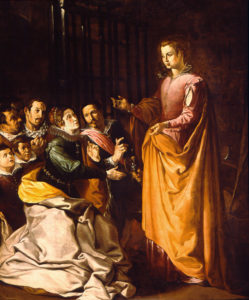Object of the Month: November 2014
St. Catherine of Alexandria Appearing to the Family of St. Bonaventura
Oil on canvas
Francisco de Herrera, the Elder
Spanish, c. 1590-1654
Click on the links throughout the article to view additional artists’ works and reference material.
Francisco came from a family of painters; his father was an illuminator and engraver, and his son also became a painter. He first studied with his father, Juan de Herrera Aguilar, who taught him in the Mannerist style of painting typical in late sixteenth century Seville.
His first known work is not a painting, but an engraved frontispiece for the Constituciones del Arzobispado de Sevilla (Seville, 1609). A year later, Herrera established a studio and may have been the first master of the well-known Diego Velázquez. However, a contemporary Spanish biographer, Palomino, wrote that Herrera had a terrible temper and difficulty keeping students. Nonetheless, throughout his career Herrera gained many commissions from various monasteries and convents in his hometown of Seville.
Herrera’s most significant contribution to Spanish painting is the freedom in his “modeling of forms with bold brushstrokes of solid pigment.” This mature style is evident in the present painting. “On December 30, 1627, Herrera signed a contract with the Procurator of the Franciscan College of St. Bonaventure at Seville to paint six canvases depicting scenes from the life of St. Bonaventure.” According to the contract, Herrera was to “begin work January 1, 1628, and to complete one painting every month and a half, for the sum of 900 reales for each composition. If the painter did not meet these terms, the father procurator was free to give the commission to another artist.” Herrera seems to have completed no more than four paintings including the current work along with St. Bonaventure as a Child Healed by St. Francis (Louvre, Paris), St. Bonaventure Received into the Franciscan Order (Prado, Madrid), and St. Bonaventure Receiving Communion from an Angel (Louvre, Paris).
It is not known why Herrera did not complete the commission. It could have been that he simply had too many commissions at one time. Besides the four works for St. Bonaventure, he was to complete the main altar and decorations for the Franciscan Monastery of Santa Ines, a Last Judgment for the Church of San Bernardo in Seville among others. The fact that Zurbarán had just arrived in town may have also played a role in the procurator’s decision to give the remainder of the commission to him instead of Herrera.
John M. Nolan, Curator
Published in 2014
